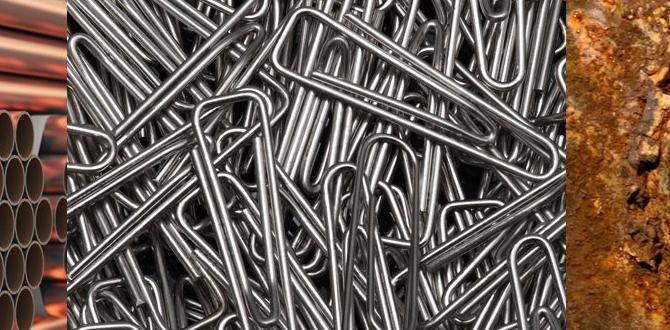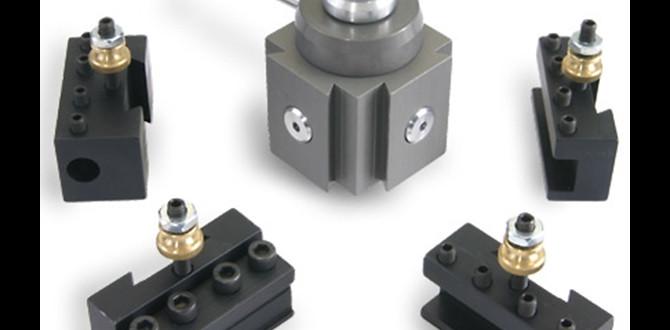A 1/8 inch carbide end mill with low runout is crucial for precise, clean cuts and avoiding tool breakage in milling operations, especially for intricate work. Choosing one with the right specifications ensures smooth finishes and extends your tool’s life.
Hey there, makers and machinists! Daniel Bates here from Lathe Hub. Ever faced the frustration of a tiny end mill chattering, leaving a rough surface, or worse, snapping mid-cut on your project? It’s a common headache, especially when working with smaller diameters like the versatile 1/8 inch. This little workhorse is fantastic for detailed jobs, but it demands precision. That’s where the magic of “low runout” comes in. Don’t worry if it sounds technical; I’m here to demystify it. We’ll dive deep into what makes a 1/8 inch carbide end mill truly effective, focusing on essential features that guarantee accuracy and durability. Stick around, and you’ll be making those perfect, clean cuts in no time!
What is a 1/8 Inch Carbide End Mill and Why Does Low Runout Matter?
Let’s start with the basics. A carbide end mill is a cutting tool used in milling machines to create slots, pockets, and profiles in materials like metal, wood, and plastic. The “1/8 inch” refers to its cutting diameter, a size perfect for detailed work, engraving, and smaller machining tasks. Carbide” means it’s made from tungsten carbide, a super-hard material that holds its edge exceptionally well and can cut tougher materials than high-speed steel (HSS) tools.
Now, “runout.” This is a critical concept for anyone serious about precision machining. In simple terms, runout is the amount a cutting tool deviates from its intended path as it rotates. Imagine a perfectly straight line drawn by a spinning pen – if the pen wobbles, the line won’t be straight. That wobble is runout.
For a 1/8 inch end mill, even a tiny amount of runout can cause significant problems:
Poor Surface Finish: Wobbling leads to uneven cutting, resulting in a rough, textured surface instead of a smooth, clean finish. This is especially noticeable on detailed work where precision is key.
Increased Tool Wear: When an end mill wobbles, some cutting edges are engaged more deeply than others or are subjected to uneven forces. This concentrates wear on specific parts of the tool, shortening its lifespan.
Chatter and Vibration: Runout is a major contributor to chatter – that annoying vibration that shakes your workpiece and tool. Chatter not only ruins your finish but can also lead to tool breakage.
Inaccurate Dimensions: If the tool isn’t spinning perfectly true, the dimensions of your cuts will be off. For a 1/8 inch mill, this can mean the difference between a snug fit and a loose one.
Increased Risk of Breakage: The uneven forces and vibrations caused by runout put immense stress on a small cutting tool. A 1/8 inch end mill is already delicate by nature, and runout significantly increases the chance of it snapping.
A “low runout” carbide end mill is designed and manufactured to minimize this deviation. This means the cutting edges follow a much truer circular path, leading to cleaner cuts, longer tool life, and more predictable results. For intricate work, particularly when using smaller tools like a 1/8 inch end mill, investing in low runout is not a luxury; it’s a necessity for success.
Key Features of a Quality 1/8 Inch Carbide End Mill
When you’re looking for a 1/8 inch carbide end mill, especially one focused on low runout, several features set the good ones apart from the rest. Understanding these will help you make a smart choice for your projects.
1. Material (Tungsten Carbide Grade)
Carbide itself is a family of materials, and the specific grade of tungsten carbide used can affect performance. For general machining, a sub-micron or fine-grain carbide offers a good balance of hardness and toughness. Higher-end carbides might be specified for specific extreme applications, but for most beginner and hobbyist uses, a standard, reputable carbide grade will do the job.
2. Shank Diameter and Type
While we’re focusing on a 1/8 inch cutting diameter, the shank (the part that goes into the collet or tool holder) matters. You’ll often see:
1/8 inch Shank: This is common and fits directly into 1/8 inch collets or holders.
4mm Shank: Increasingly popular, especially for smaller CNC machines and 3D printers.
6mm, 8mm, or 10mm Shank: These larger shanks offer more rigidity and can help reduce runout when used with larger collets or tool holders, even though the cutting diameter is only 1/8 inch. A 10mm shank on a 1/8 inch end mill is a common configuration for increased stability.
The key takeaway here is that a larger shank diameter, when properly held in a matching collet or tool holder, can contribute to better rigidity and less perceived runout, even if the cutting portion is small.
3. Flute Count (Number of Edges)
End mills come with different numbers of flutes:
2 Flutes: Best for slotting and general-purpose cutting, especially in softer materials. They have more chip clearance.
3 Flutes: A good compromise for milling slots and pockets in harder metals. They offer better stability than 2-flute but less chip clearance.
4 Flutes: Ideal for finishing operations and for cutting harder materials. They provide the best surface finish and tool rigidity but have the least chip clearance.
For general 1/8 inch work, 2 or 4 flutes are most common. If you’re doing a lot of slotting, 2 flutes are excellent. For cleaner finishing or harder materials, 4 flutes can be better.
4. Coatings
Some carbide end mills come with coatings to improve performance:
Bright (Uncoated): Suitable for general use and softer materials. They are less expensive.
TiN (Titanium Nitride): A common gold-colored coating that increases surface hardness and reduces friction, offering better tool life in many applications.
TiCN (Titanium Carbonitride): A grey/black coating that is harder than TiN and offers better abrasion resistance, good for tougher metals.
AlTiN (Aluminum Titanium Nitride): Black/purple, excellent for high-temperature applications and machining stainless steel and other challenging alloys.
For a beginner, an uncoated or TiN-coated end mill is usually a good starting point.
5. End Geometry
The shape of the cutting end of the mill:
Square End: The most common type, with a flat cutting face.
Ball End: Has a rounded tip, used for creating contoured surfaces and fillets.
Corner Radius: A square end mill with slightly rounded corners to help prevent chipping and improve strength. This is often a good choice for general-purpose milling as it offers a bit more robustness.
6. Helix Angle
This refers to the angle of the flutes. Common helix angles include:
30 Degrees: A standard, general-purpose helix angle.
45 Degrees: Offers a balance of cutting action and rigidity.
60 Degrees: Provides a more aggressive cutting action and can be good for chip evacuation.
For a 1/8 inch end mill, a standard 30-degree helix is very common and effective for general use.
The Importance of Collet Quality for Runout
Even the best low-runout end mill can perform poorly if it’s not held correctly. The collet (the part that grips the end mill in your machine’s spindle) plays a massive role in how accurately the tool rotates.
Collet Runout: High-quality collets are precision-ground to have very low runout themselves. A worn or cheap collet can introduce significant wobble, negating the benefits of a good end mill.
Collet Size: Always use a collet that closely matches your end mill’s shank diameter. For a 1/8 inch end mill, you’d ideally use a 1/8 inch collet. If you have a 1/8 inch end mill with a 10mm shank, you’d need a 10mm collet. Using an adapter or a collet that’s too large will increase runout.
Cleanliness: Ensure your collet and the tool holder are perfectly clean, free from chips, oil, or debris. Contamination can easily cause runout.
Reputable tool holders and collet systems, like those from GRIZZLY.COM, emphasize the precision needed for accurate machining.
Step-by-Step: Selecting Your 1/8 Inch Carbide End Mill
Choosing the right tool doesn’t have to be complicated. Here’s a simple guide:
1. Identify Your Material: What will you be cutting? Softwoods, hardwoods, plastics, aluminum, mild steel? This dictates the type of carbide and flute count.
Soft plastics/woods: 2-flute, uncoated or AlTiN is fine.
Aluminum: 2 or 3-flute, uncoated or TiN. Good chip clearance is helpful.
Mild Steel: 3 or 4-flute, TiN or TiCN coating.
Harder metals (stainless steel): 4-flute, AlTiN coating, and look for tools specifically rated for these materials.
2. Determine Shank Size Needs: Do you have 1/8 inch collets, or do you need a larger shank (like 10mm) for more rigidity and a larger collet? For stability with a 1/8 inch cutter, a 10mm shank often provides a noticeable improvement.
3. Consider the Operation: Are you roughing, slotting, pocketing, or finishing?
Slotting/Roughing: 2-flute for max chip clearance.
General Purpose/Pocketing: 2 or 3-flute can work.
Finishing: 4-flute for best surface finish.
4. Look for “Low Runout” or High Precision: Many manufacturers will advertise tools as “high precision” or “low runout.” These are the ones to seek out. A tighter manufacturing tolerance is key.
5. Check for Corner Radius (Optional but Recommended): For general use, a small corner radius (e.g., 0.010″ or 0.25mm) adds strength and helps avoid chipping on the corners.
6. Consider Brand Reputation: Stick with well-known brands that specialize in cutting tools. They often have better quality control and material specifications.
Table: Choosing the Right 1/8 Inch End Mill for Common Materials
| Material | Shank Size Preference | Flute Count | Recommended Coating | Common End Geometry | Notes |
| :—————— | :——————– | :———- | :—————— | :—————— | :——————————————————- |
| Softwoods/Plastics | 1/8″ or 4mm | 2 | Bright or TiN | Square or Ball | Focus on chip evacuation. |
| Hardwoods | 1/8″ or 4mm | 2 or 4 | Bright or TiN | Square | 4-flute gives a smoother finish. |
| Aluminum | 1/8″ or 4mm | 2 or 3 | Bright or TiN | Square | Good chip clearance is vital to prevent sticking. |
| Mild Steel | 1/8″ or 10mm | 3 or 4 | TiN or TiCN | Square or Corner Rad| Requires a more robust tool and coating. |
| Stainless Steel | 10mm | 4 | AlTiN | Square or Corner Rad| High heat; robust tool and coating are essential. |
Note: “Long reach” refers to the length of the cutting flutes. Ensure the reach suits your depth of cut requirements, but be aware that longer tools are more prone to deflection and vibration.
Using a 1/8 Inch Carbide End Mill Safely and Effectively
Safety and proper technique are paramount, especially with small, precise tools.
Setting Up Your Machine
Clean Spindle and Collet: Before inserting the end mill, ensure the spindle taper and the collet are spotless. Use compressed air or a clean cloth.
Proper Collet Insertion: Insert the collet firmly into the tool holder or spindle, then insert the end mill shank. Tighten according to your machine’s instructions. Do NOT overtighten, as this can damage the collet or spindle.
Secure Your Workpiece: Use appropriate clamps, vises, or jigs to hold your workpiece firmly. A loose workpiece is a recipe for disaster.
Check Tool Projection: Ensure only the necessary amount of the end mill is protruding from the collet. Excessive projection increases the risk of vibration and breakage.
Machining Parameters (Speeds and Feeds)
This is where things get specific, and “speeds and feeds” can seem daunting. For a 1/8 inch carbide end mill cutting metal, you’ll generally need to run your spindle faster than you would with a larger tool, but you’ll feed it slower.
Spindle Speed (RPM): Carbide excels at high speeds. For a 1/8 inch end mill in aluminum, you might run at 15,000-30,000 RPM on a CNC. For manual machines, you’ll use the highest speed setting available.
Feed Rate (IPM or mm/min): This is how fast the tool moves through the material. It’s crucial to have a feed rate that’s fast enough to allow the cutting edges to shear material cleanly, rather than rub or rub. For 1/8 inch in aluminum, this might be as low as 5-15 IPM.
Depth of Cut (DOC): For small end mills, take shallow cuts. For a 1/8 inch diameter, a depth of cut of 0.010″ to 0.030″ (0.25mm to 0.75mm) is often a good starting point for metals. You can experiment with slightly deeper cuts if your machine is rigid and the tool is performing well.
Stepover: This is the distance the tool moves sideways for each pass. For finishing, aim for a small stepover (e.g., 10-30% of tool diameter). For roughing, you can increase this.
Helpful Resources for Speeds and Feeds:
Manufacturer’s Recommendations: Always check the end mill manufacturer’s website or packaging for suggested cutting parameters.
Online Calculators: Many machining websites offer speeds and feeds calculators. For example, G-Wizard Estimator is a comprehensive tool (though it’s a paid product, it offers insights).
Machining Forums and Communities: Fellow machinists are a great resource. Ask for advice based on your specific machine and material.
Achieving Low Runout in Practice
Use High-Quality Collets: This cannot be stressed enough. A good set of ER collets or a high-precision chuck will make a world of difference.
Minimize Tool Extension: Keep the length of the end mill sticking out of the collet as short as possible to achieve the desired cut depth.
Listen to Your Machine: Chatter is your enemy. If you hear it, slow down your feed rate, reduce your depth of cut, or check your setup for looseness or excessive runout.
Take Light Finishing Passes: After roughing out a shape, a final light pass with a small stepover and a focused effort on achieving a good finish can greatly improve the surface quality.
Example Scenario: Milling a Small Slot in Aluminum
Let’s say you need to mill a precise 1/8 inch wide slot in a piece of 6061 aluminum, about 0.100 inches (2.5mm) deep.
1. Tool Selection: You’d choose a 1/8 inch 2-flute carbide end mill. To maximize stability and minimize runout, you opt for one with a 10mm shank. An uncoated or TiN-coated mill would be suitable.
2. Machine Setup: Mount the aluminum securely in a milling vise. Ensure your milling machine’s spindle and your 10mm collet are clean. Insert the end mill into the 10mm collet, leaving just enough flute length exposed to make the 0.100″ cut.
3. Parameters (Example for a CNC mill with a high-speed spindle):
Spindle Speed: 20,000 RPM
Feed Rate: 12 IPM (inches per minute)
Depth of Cut: Take the 0.100″ cut in two passes: 0.050″ each.
Stepover: For a 1/8″ slot, you can often make a full-width cut by directly plunging or using shallow ramping, but for a clean slot start, a small stepover to initiate might be used if not plunging directly.
4. Execution:
First Pass (0.050″ depth): Start the spindle, then engage the feed. Listen for smooth cutting.
Second Pass (0.050″ depth): Increase the Z-depth to 0.100″ and make the second pass.







